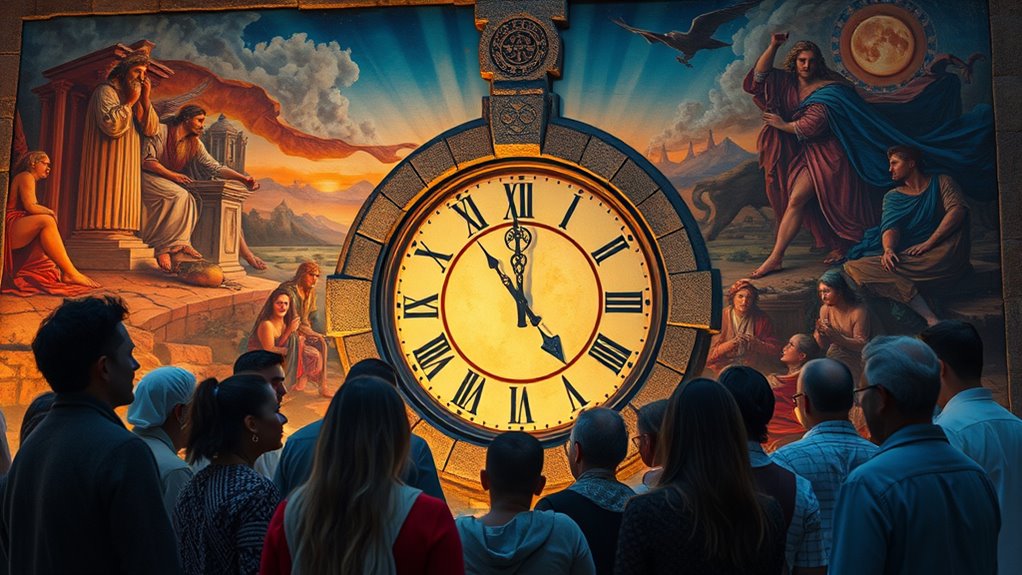The Millennium refers to a future period of peace and Christ’s reign, but Christians interpret it differently. Premillennialism believes Jesus returns before a literal 1,000 years of peace on earth. Amillennialism sees the Millennium as a symbolic spiritual reign happening now through the church. Postmillennialism expects Christ to come after a long era of societal Christian influence. Understanding these views helps clarify how biblical prophecies shape Christian expectations—stay with us to explore each perspective in detail.
Key Takeaways
- Premillennialism expects Christ’s literal return before a 1,000-year reign on earth; Amillennialism sees the millennium as symbolic of the current spiritual reign; Postmillennialism believes Christ returns after a period of societal Christian influence.
- Premillennialists interpret Revelation 20 literally, emphasizing a future physical kingdom; Amillennialists interpret it symbolically, viewing the reign as spiritual; Postmillennialists see it as a gradual societal Christianization.
- Premillennialism emphasizes a future, physical reign of Christ; Amillennialism sees Christ’s reign as ongoing spiritually; Postmillennialism focuses on societal transformation before Christ’s return.
- These views influence Christian living, with premillennialism fostering urgency, amillennialism emphasizing spiritual growth, and postmillennialism encouraging active cultural engagement.
- The differing interpretations impact theological debates, biblical symbolism, and perspectives on societal progress within Christian eschatology.
Defining the Millennium in Biblical Context

The concept of the millennium in the Bible refers to a future period of peace and righteousness, often associated with the reign of Christ. Many interpret this period through symbolic interpretation, viewing the thousand years as a metaphor for a complete, divine era rather than a literal timeframe. Historical symbolism plays a key role here, as some see the references as reflecting ongoing spiritual truths rather than specific future events. This approach emphasizes understanding biblical language within its cultural and historical context, rather than taking it solely at face value. By exploring these symbolic and historical aspects, you can gain a deeper appreciation of how the millennium represents God’s ultimate plan for establishing His kingdom on earth.
Origins and Development of Premillennialism

You’ll see that premillennialism has deep roots in church history, shaped by early interpretations and influences. Key theological figures have played crucial roles in developing and defending this view over time. Understanding these origins helps clarify how premillennial thought evolved into what it is today.
Historical Roots and Influences
Understanding the origins of premillennialism requires examining its roots in early Christian thought and historical developments. During the Early Church, believers anticipated Christ’s literal return and a future earthly kingdom, shaping premillennial ideas. Medieval scholars also influenced these views, drawing from biblical interpretations and eschatological debates. They often emphasized a future, physical reign of Christ on earth, reinforcing premillennial expectations. These historical perspectives laid the groundwork for later theological reflections, even as interpretations evolved over centuries. The early church’s literal approach to prophecy and the medieval focus on Christ’s tangible reign contributed profoundly to the development of premillennial thought. By understanding these roots, you see how historical influences shaped the core ideas that persist in premillennialism today.
Key Theological Figures
Have key theological figures shaped the development of premillennialism from its origins? Absolutely. Early thinkers like Irenaeus and Justin Martyr laid the groundwork by interpreting biblical prophecy through eschatological symbolism, emphasizing a literal future kingdom. Later, John Nelson Darby refined these ideas in the 19th century, emphasizing a literal interpretation of biblical prophecy and a future earthly reign of Christ. C.H. Spurgeon and others contributed to popularizing premillennial views within evangelical circles. These figures helped shape the understanding that biblical prophecy points toward a literal, physical millennial kingdom. Their interpretations influenced how believers see the future, anchoring premillennialism firmly in biblical prophecy and eschatological symbolism. Their contributions remain central to the development and spread of premillennial thought today.
Core Beliefs of Amillennialism

What are the core beliefs that define amillennialism? You understand that it views the thousand-year reign symbolically, not as a literal future event. Instead, the amillennial perspective sees Christ’s reign as spiritual, occurring now through His church and believers. This belief relies on symbolic interpretation of biblical prophecy, especially Revelation 20, emphasizing that the Millennium is fulfilled in the present era. You recognize that the kingdom of God isn’t a future physical domain but a spiritual fulfillment experienced through faith, obedience, and the spread of the Gospel. Amillennialism teaches that Christ’s second coming, resurrection, and final judgment will happen at the end of this spiritual reign, making the current age a fulfillment of God’s promises rather than an anticipation of a future earthly kingdom.
Understanding Postmillennialism

Postmillennialism presents a view of biblical prophecy that sees the kingdom of God as progressively advancing through the spread of the Gospel and societal transformation. You believe that Christ’s reign will be realized gradually, influencing culture and history before His return. This perspective emphasizes faith and prophecy working together, with historical context shaping the church’s role in societal change. Postmillennials see the current age as a period of growth, where Christ’s influence deepens across nations. The table below highlights key aspects:
| Aspect | Explanation | Biblical Support |
|---|---|---|
| Progressive Kingdom | Growth occurs over time through faith | Matthew 13:31-33 |
| Societal Transformation | Society aligns more with God’s will | Romans 8:19-21 |
| Role of the Church | Active in shaping culture | Matthew 28:19-20 |
| Second Coming | After widespread Christian dominance | Revelation 20:1-6 |
Key Biblical Passages Supporting Premillennialism

Several key biblical passages support premillennialism by emphasizing a future, literal reign of Christ on earth before the final judgment. For example, Revelation 20:1-6 describes Satan’s imprisonment and Christ’s thousand-year reign, which many interpret literally rather than symbolically. While some see this as prophetic symbolism, premillennialists argue these passages point to a concrete future event. Additionally, passages like Zechariah 14:4-9 describe Christ’s physical return to Jerusalem to establish His kingdom, reinforcing the view of a literal millennial reign. These scriptures suggest a future era of peace and righteousness, supporting the premillennial expectation of Christ’s tangible, earthly reign before eternity begins. This interpretation often resists symbolic interpretation, favoring a straightforward understanding of biblical prophecy.
How Amillennialism Interprets Revelation 20

How does amillennialism interpret Revelation 20 differently from premillennialism? Instead of a literal, future earthly reign, amillennialists see this chapter as a symbolic interpretation of Christ’s spiritual fulfillment. They believe the “thousand years” represents the current reign of Christ and His saints from heaven, ongoing throughout the church age. The binding of Satan symbolizes his limited influence, not a future event.
| Amillennial View | Premillennial View |
|---|---|
| Symbolic interpretation | Literal future reign |
| Present spiritual fulfillment | Future earthly kingdom |
| Satan bound now | Satan bound in the future |
| Christ reigning spiritually | Christ reigning physically |
| No literal millennium | Future literal thousand years |
The Optimistic Outlook of Postmillennialism

Postmillennialism holds an optimistic view of the future, believing that cultural transformation and gospel expansion will bring about widespread positive change. You can see this perspective in the hope that society will increasingly reflect Christian principles as the gospel spreads. This outlook encourages believers to actively participate in shaping a better world through faith and outreach.
Cultural Transformation Perspective
The Cultural Transformation Perspective within postmillennialism offers an optimistic view that societal progress is both possible and inevitable through the spread of Christian values. You believe that, despite a prevailing secular worldview, positive change can occur as Christian principles influence culture, laws, and institutions. Technological influence plays a key role here, accelerating the dissemination of biblical ideas and fostering societal renewal. You see history not as a cycle of decline but as a trajectory toward greater justice and righteousness, driven by Christian engagement in all areas of life. This perspective encourages active participation, trusting that spiritual transformation will manifest in improved communities, education, and governance. Ultimately, you view cultural transformation as evidence of God’s ongoing work through His people, shaping a hopeful future.
Gospel Expansion Impact
Gospel expansion under the postmillennial perspective is seen as a powerful force transforming society from within. You believe that through dedicated evangelism strategies, church growth accelerates, bringing more people into the faith. This optimistic outlook suggests that as the gospel spreads, societal values shift toward justice, peace, and righteousness. You’re encouraged to actively participate in outreach, knowing that your efforts contribute to a broader spiritual renewal. The following table highlights key aspects of this impact:
| Aspect | Action | Result |
|---|---|---|
| Church Growth | Focused evangelism strategies | Increased membership |
| Society Transformation | Gospel influences culture | Greater social justice |
| Personal Impact | Sharing faith actively | Strengthened community |
| Global Reach | Missionary efforts | Worldwide spiritual revival |
Comparing the Timeline of Christ’s Return in Each View

Understanding how each premill, amill, and postmill view sequences Christ’s return reveals fundamental differences in their timelines. In premill views, the rapture occurs before a literal millennium, with Christ returning physically afterward to reign for a thousand years, emphasizing the millennium symbolism as a future, literal event. Amillennials see the millennium as a spiritual reign happening now, with Christ’s return occurring at the end of this spiritual period, making the rapture a symbolic or non-physical event. Postmillennials believe Christ returns after a long period of Christian influence on earth, with the rapture either happening at the end of this age or simultaneously with Christ’s second coming. These timelines shape how each view perceives the sequence and significance of Christ’s return in relation to the millennium.
The Influence of These Views on Christian Living and Eschatology

Your beliefs about the timing of Christ’s return profoundly shape how you live daily and how you interpret your spiritual journey. These views influence your understanding of eschatological symbolism, shaping how you see God’s plan unfolding. For example, premillennialism emphasizes an imminent physical return, fostering anticipation and urgency in evangelism. Amillennialism’s symbolic view leads you to focus on Christ’s present reign and spiritual growth, highlighting the theological implications of Christ ruling now in believers’ hearts. Postmillennialism encourages optimism about cultural transformation through the Gospel, impacting your engagement with society. Overall, each perspective guides your attitude toward hope, activism, and trust in God’s sovereignty, deeply influencing your approach to Christian living and your interpretation of biblical prophecy.
Contemporary Perspectives and Debates Surrounding the Millennium

You’ll find that contemporary debates about the millennium reflect diverse theological views and interpretations. These perspectives influence cultural and political discussions, shaping how society approaches issues of hope and justice. Exploring current trends reveals how modern thinkers continue to challenge and refine traditional eschatological ideas.
Theological Divergences Explored
Contemporary debates about the millennium often reveal deep theological divergences among Christian groups. These differences stem from varied interpretations of eschatological symbolism and biblical numerology. You should consider three key points:
- Premillennialists see the thousand years as a literal, future reign of Christ on earth, emphasizing a physical fulfillment.
- Amillennialists interpret the millennium symbolically, viewing it as the current church age, with no future literal period.
- Postmillennialists believe Christ returns after a golden age of Christian influence, often linked to biblical numerology’s symbolic meaning of completeness.
These perspectives highlight how biblical numerology and eschatological symbolism shape distinct theological views, fueling ongoing debates. Understanding these nuances helps clarify why interpretations of the millennium continue to diverge among Christians today.
Cultural and Political Impact
The different millennial views continue to influence cultural and political debates, shaping how Christians engage with society’s future. Secular viewpoints often interpret millennial ideas as symbolic of broader social progress or decline, impacting public policy and cultural values. Premillennialism’s emphasis on a literal future kingdom can inspire activism rooted in divine intervention, while amillennialism’s focus on the present spiritual reign encourages social justice initiatives without waiting for a literal millennium. Postmillennialism’s belief in progress through Christ’s influence in history fosters optimism about societal transformation. These perspectives shape political implications, influencing debates on issues like morality, human rights, and the role of religion in public life. As these views evolve, they continue to inform how faith intersects with societal progress and governance.
Modern Interpretative Trends
Modern interpretative trends reveal a dynamic landscape where believers and scholars continuously reexamine millennial ideas in light of current social, technological, and theological developments. These trends often challenge traditional views by exploring new insights into eschatological symbolism and biblical prophecy interpretation. You may notice three key shifts:
- Re-evaluating symbolic language to better align with contemporary understandings of history and future events.
- Emphasizing the spiritual and allegorical aspects of prophecy over literal timelines.
- Integrating scientific and cultural advancements to contextualize millennial debates without dismissing theological significance.
This ongoing dialogue encourages believers to see the millennium not just as a future event but as a dynamic element of faith that interacts with modern perspectives. These debates keep the conversation relevant and evolving in today’s theological landscape.
Frequently Asked Questions
How Do These Views Impact Christian Worship Practices?
Your view of the millennium shapes your worship focus. If you see it as symbolic, you might emphasize spiritual renewal and divine promises in worship. Premillennials may prioritize anticipation of Christ’s literal return, influencing practices to reflect hope and readiness. Amillennials focus on present spiritual realities, encouraging worship that celebrates Christ’s reign now. Postmillennials often see history as progressing toward Christ’s reign, shaping worship that emphasizes mission and kingdom-building.
What Historical Figures Championed Each Millennial View?
Imagine a grand tapestry of eschatological symbolism, where each thread represents a different view. You see premillennialists like John Nelson Darby, who envisioned a literal kingdom. Amillennialists such as Augustine interpret the symbolism spiritually, while postmillennialists like Jonathan Edwards see history gradually fulfilling God’s promises. These figures shape the theological implications, guiding how believers understand the timing and nature of Christ’s return within this rich historical mosaic.
How Do These Interpretations Influence Christian Political Engagement?
You see, your eschatology politics and theological activism are shaped by how you interpret the millennium. Premillennialists often advocate for active political engagement, expecting Christ’s imminent return to influence societal change. Amillennials see this age as ongoing, encouraging a spiritual approach to politics. Postmillennials believe in shaping history through Christian influence, promoting societal transformation. Your view guides your engagement, influencing whether you focus on activism, spiritual renewal, or cultural transformation.
Are There Any Denominations That Reject All Three Views?
You might wonder if any denominations reject all three eschatology views—Premill, Amill, and Postmill—due to doctrinal disagreements. Some groups, especially those emphasizing a symbolic or non-literal interpretation of Revelation, may not align strictly with these views. Eschatology diversity exists across Christianity, so it’s possible you’ll find denominations that avoid these specific frameworks altogether, focusing instead on broader spiritual or allegorical understandings instead of detailed millennial timelines.
How Do These Theories Relate to Modern Secular Perspectives?
Imagine a vast ocean where different ships sail, each representing a worldview. Your modern worldview often sees history and prophecy through a secular interpretation, focusing on human progress rather than divine timelines. These millennial theories, rooted in spiritual prophecy, clash with secular perspectives that view history as a series of human achievements. While some may see them as incompatible, others find ways to bridge faith and reason, steering the waters of belief and skepticism.
Conclusion
Understanding the different views on the millennium shapes your perspective on Christ’s return. Whether you see it as a literal future event, a present spiritual reality, or a gradual societal transformation, each outlook influences how you live and hope. While premill, amill, and postmill offer contrasting timelines, they all invite you to trust in God’s promises. Ultimately, your stance reflects your faith’s focus—either waiting, reigning now, or transforming the world.










